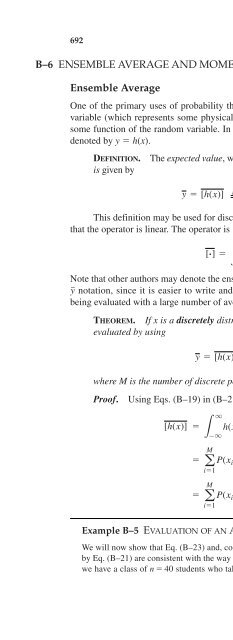563489578934
692 Probability and Random Variables Appendix B B–6 ENSEMBLE AVERAGE AND MOMENTS Ensemble Average One of the primary uses of probability theory is to evaluate the average value of a random variable (which represents some physical phenomenon) or to evaluate the average value of some function of the random variable. In general, let the function of the random variable be denoted by y = h(x). DEFINITION. is given by The expected value, which is also called the ensemble average, of y = h(x) (B–21) This definition may be used for discrete, as well as continuous, random variables. Note that the operator is linear. The operator is (B–22) Note that other authors may denote the ensemble average of y by E [y] or 8y 9. We will use the yq notation, since it is easier to write and more convenient to use when long equations are being evaluated with a large number of averaging operators. THEOREM. If x is a discretely distributed random variable, the expected value can be evaluated by using where M is the number of discrete points in the distribution. Proof. q y = [h(x)] ! [h(x)] f(x) dx L [# ] = L q y = [h(x)] = a M Using Eqs. (B–19) in (B–21), we get q M [h(x)] = h(x) c a P(x i ) d(x - x i ) d dx L - q M q = a P(x i ) h(x)d(x - x i ) dx L i=1 M = a P(x i )h(x i ) i=1 - q - q i=1 -q [# ] f(x) dx i=1 h(x i )P(x i ) (B–23) Example B–5 EVALUATION OF AN AVERAGE We will now show that Eq. (B–23) and, consequently, the definition of expected value as given by Eq. (B–21) are consistent with the way in which we usually evaluate averages. Suppose that we have a class of n = 40 students who take a test. The resulting test scores are l paper with a
- Page 1382: Problems 667 the IF band of the sat
- Page 1386: A p p e n d i x MATHEMATICAL TECHNI
- Page 1390: A-4 Integral Calculus 671 d sin ax
- Page 1394: A-5 Integral Tables 673 L x2 cos x
- Page 1398: A-8 The Dirac Delta Function 675 A-
- Page 1402: A-9 Tabulation of Sa(x) = (sin x)/x
- Page 1406: A-10 Tabulation of Q (z) 679 z Q(z)
- Page 1410: B-2 Sets 681 used when conversing w
- Page 1414: B-3 Probability and Relative Freque
- Page 1418: B-5 Cumulative Distribution Functio
- Page 1422: B-5 Cumulative Distribution Functio
- Page 1426: B-5 Cumulative Distribution Functio
- Page 1430: B-5 Cumulative Distribution Functio
- Page 1436: 694 Probability and Random Variable
- Page 1440: TABLE B-1 SOME DISTRIBUTIONS AND TH
- Page 1444: 698 Probability and Random Variable
- Page 1448: 700 Probability and Random Variable
- Page 1452: 702 Probability and Random Variable
- Page 1456: ƒ ƒ 704 Probability and Random Va
- Page 1460: 706 Probability and Random Variable
- Page 1464: 708 Probability and Random Variable
- Page 1468: 710 3. F(a 1 , a 2 ,..., a N ) Prob
- Page 1472: 712 Probability and Random Variable
- Page 1476: 714 Probability and Random Variable
- Page 1480: 716 Probability and Random Variable
692<br />
Probability and Random Variables<br />
Appendix B<br />
B–6 ENSEMBLE AVERAGE AND MOMENTS<br />
Ensemble Average<br />
One of the primary uses of probability theory is to evaluate the average value of a random<br />
variable (which represents some physical phenomenon) or to evaluate the average value of<br />
some function of the random variable. In general, let the function of the random variable be<br />
denoted by y = h(x).<br />
DEFINITION.<br />
is given by<br />
The expected value, which is also called the ensemble average, of y = h(x)<br />
(B–21)<br />
This definition may be used for discrete, as well as continuous, random variables. Note<br />
that the operator is linear. The operator is<br />
(B–22)<br />
Note that other authors may denote the ensemble average of y by E [y] or 8y 9. We will use the<br />
yq notation, since it is easier to write and more convenient to use when long equations are<br />
being evaluated with a large number of averaging operators.<br />
THEOREM. If x is a discretely distributed random variable, the expected value can be<br />
evaluated by using<br />
where M is the number of discrete points in the distribution.<br />
Proof.<br />
q<br />
y = [h(x)] ! [h(x)] f(x) dx<br />
L<br />
[# ] =<br />
L<br />
q<br />
y = [h(x)] = a<br />
M<br />
Using Eqs. (B–19) in (B–21), we get<br />
q M<br />
[h(x)] = h(x) c a P(x i ) d(x - x i ) d dx<br />
L<br />
- q<br />
M q<br />
= a P(x i ) h(x)d(x - x i ) dx<br />
L<br />
i=1<br />
M<br />
= a P(x i )h(x i )<br />
i=1<br />
- q<br />
- q<br />
i=1<br />
-q<br />
[# ] f(x) dx<br />
i=1<br />
h(x i )P(x i )<br />
(B–23)<br />
Example B–5 EVALUATION OF AN AVERAGE<br />
We will now show that Eq. (B–23) and, consequently, the definition of expected value as given<br />
by Eq. (B–21) are consistent with the way in which we usually evaluate averages. Suppose that<br />
we have a class of n = 40 students who take a test. The resulting test scores are l paper with a



